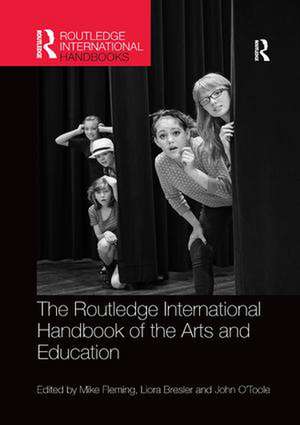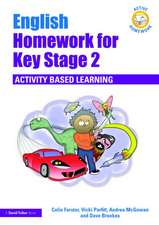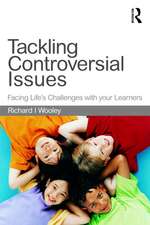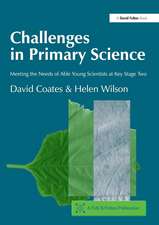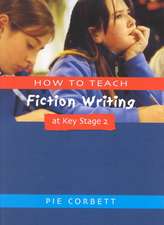The Routledge International Handbook of the Arts and Education: Routledge International Handbooks of Education
Editat de Mike Fleming, Liora Bresler, John O'Tooleen Limba Engleză Paperback – 12 oct 2017
Providing a detailed overview of key concepts and practical challenges, the book combines theoretical insight with specific examples of innovative projects drawing on theoretical, historical and empirical research perspectives to inform understanding. The range of content highlights the breadth of the field, addressing such issues as the importance of community arts and partnership as well as school education, and providing insight into developments in multiple and connecting arts as well as traditional art forms. Topics such as assessment, creativity, cultural diversity, special needs, the arts in early childhood, adult education, arts based research, are all addressed by recognised authorities in each area. The collection of chapters also serves to define the field of arts education, recognising its diversity but highlighting the common elements that provide its identity.
The collection addresses generic issues common to all the arts while acknowledging differences and recognising the dangers of over-generalisation. It also includes specific chapters on each of the art forms (visual art, dance, drama, literature, music, media arts) providing a cutting-edge analysis of key contemporary issues in each subject.
Bringing together specially commissioned pieces by a range of international authors, this Handbook will make an important contribution to the field of Arts Education.
| Toate formatele și edițiile | Preț | Express |
|---|---|---|
| Paperback (1) | 331.87 lei 6-8 săpt. | |
| Taylor & Francis – 12 oct 2017 | 331.87 lei 6-8 săpt. | |
| Hardback (1) | 1218.54 lei 6-8 săpt. | |
| Taylor & Francis – 25 noi 2014 | 1218.54 lei 6-8 săpt. |
Din seria Routledge International Handbooks of Education
-
 Preț: 385.13 lei
Preț: 385.13 lei -
 Preț: 340.74 lei
Preț: 340.74 lei - 9%
 Preț: 1491.01 lei
Preț: 1491.01 lei -
 Preț: 341.07 lei
Preț: 341.07 lei -
 Preț: 334.03 lei
Preț: 334.03 lei - 9%
 Preț: 1594.04 lei
Preț: 1594.04 lei -
 Preț: 367.55 lei
Preț: 367.55 lei -
 Preț: 471.80 lei
Preț: 471.80 lei - 12%
 Preț: 331.87 lei
Preț: 331.87 lei -
 Preț: 422.58 lei
Preț: 422.58 lei - 29%
 Preț: 1185.83 lei
Preț: 1185.83 lei -
 Preț: 416.22 lei
Preț: 416.22 lei -
 Preț: 466.02 lei
Preț: 466.02 lei -
 Preț: 455.78 lei
Preț: 455.78 lei - 18%
 Preț: 1574.36 lei
Preț: 1574.36 lei - 22%
 Preț: 455.27 lei
Preț: 455.27 lei - 11%
 Preț: 302.55 lei
Preț: 302.55 lei - 12%
 Preț: 331.87 lei
Preț: 331.87 lei - 12%
 Preț: 331.87 lei
Preț: 331.87 lei - 25%
 Preț: 541.50 lei
Preț: 541.50 lei - 31%
 Preț: 1830.09 lei
Preț: 1830.09 lei - 25%
 Preț: 1194.82 lei
Preț: 1194.82 lei - 18%
 Preț: 1568.21 lei
Preț: 1568.21 lei - 11%
 Preț: 341.86 lei
Preț: 341.86 lei - 18%
 Preț: 1554.29 lei
Preț: 1554.29 lei - 24%
 Preț: 426.49 lei
Preț: 426.49 lei - 15%
 Preț: 572.34 lei
Preț: 572.34 lei - 18%
 Preț: 1557.14 lei
Preț: 1557.14 lei - 18%
 Preț: 1617.55 lei
Preț: 1617.55 lei -
 Preț: 455.78 lei
Preț: 455.78 lei - 18%
 Preț: 1571.83 lei
Preț: 1571.83 lei - 15%
 Preț: 567.41 lei
Preț: 567.41 lei - 11%
 Preț: 343.25 lei
Preț: 343.25 lei - 31%
 Preț: 1689.67 lei
Preț: 1689.67 lei - 11%
 Preț: 339.94 lei
Preț: 339.94 lei
Preț: 331.87 lei
Preț vechi: 379.25 lei
-12% Nou
Puncte Express: 498
Preț estimativ în valută:
63.51€ • 68.96$ • 53.35£
63.51€ • 68.96$ • 53.35£
Carte tipărită la comandă
Livrare economică 22 aprilie-06 mai
Preluare comenzi: 021 569.72.76
Specificații
ISBN-13: 9781138577275
ISBN-10: 1138577278
Pagini: 442
Ilustrații: 6 Line drawings, black and white; 3 Halftones, black and white; 6 Tables, black and white; 9 Illustrations, black and white
Dimensiuni: 174 x 246 x 30 mm
Greutate: 0.45 kg
Ediția:1
Editura: Taylor & Francis
Colecția Routledge
Seria Routledge International Handbooks of Education
Locul publicării:Oxford, United Kingdom
ISBN-10: 1138577278
Pagini: 442
Ilustrații: 6 Line drawings, black and white; 3 Halftones, black and white; 6 Tables, black and white; 9 Illustrations, black and white
Dimensiuni: 174 x 246 x 30 mm
Greutate: 0.45 kg
Ediția:1
Editura: Taylor & Francis
Colecția Routledge
Seria Routledge International Handbooks of Education
Locul publicării:Oxford, United Kingdom
Public țintă
Postgraduate and UndergraduateCuprins
1. Introduction Part One: The Role of Theory Introduction 2. A Place for Beauty in Arts Education (Joe Winston) 3. Bildung - Between cultural heritage and the unknown, instrumentalism and existence (Øivind Varkøy) 4. Hunting high and low, The rise, fall and concealed return of a key dichotomy in music and arts education (Petter Dyndahl ) 5. Hume’s ‘Of the Standard of Taste’ and Education and the Arts (John Gingell) 6. Creativity in the Arts and Arts Education: Intentionally reclaiming our rightful, central place (Eric Booth) 7. Embodied arts experience : the educational value of somaesthetics (Christine Doddington) 8. Visual Metaphors: Meaning, interpretation and culture (Michael Parsons) Part Two: Historical Perspectives Introduction 9. Whose arts education? International and intercultural dialogue (Emily Akuno, Leopold Klepacki, Mei-Chun Lin, John O’Toole, Tia Reihana, Ernst Wagner, Gloria Zapata Restrepo) 10. The Role of the Arts in Society (Sophie Claire Ward) 11. The absent recognition of heteronomous arts education (Bjørn Rasmussen) 12. The Ordeal of Consciousness and the Arts of Freedom (Chris Higgins) Part Three: Arts Education and the Curriculum Introduction 13. Visual Art in the Curriculum (Richard Hickman & Kristen Ali Eglinton) 14. Metaphors, Musicianship, and Innovation in the Music Curriculum (Janet R. Barrett) 15. Threshold concepts, academic identity and arts curricula design: Dr Who and Indiana Jones traverse learning landscapes for dance (Ralph Buck and Nicholas Rowe) 16. When advocacy meets opportunity… what’s the reality? Establishing drama in the curriculum (John O’Toole) 17. Literature and the Curriculum (Irene Pieper) 18. The Paradox of Poetry Education (Mark Dressman) 19. The work of Media Arts in the age of digital production (Michael Dezuanni ) 20. Signs, meaning and embodiment: Learning and pedagogy in the early years (Julie Dunn and Susan Wright) 21. ‘Aesthetic Learning for All’ – Drama in Education for Children with Special Educational Needs (Melanie Peter) 22. Art education and therapy: the importance of Dramatherapy (Sue Jennings and Penny McFarlane) 23. Assessing Diverse Creativities in Music: a Spectrum of Challenges, Possibilities and Practices (Pam Burnard and Martin Fautley) 24. Arts Integration: Reunion for a Creative Curriculum (Madeleine R. Grumet, Deborah Randolph, and Faye Stanley) Part Four: Arts Education and the Wider Community Introduction 25. Community-Based Arts and Education in Partnership: Possibilities and Challenges (Samuel Leong) 26. Arts in the community as a place-making event (Pat Thomson, Andy Barrett, Christine Hall, Julian Hanby and Susan Jones) 27. A fragile dance: art and place making in times of war and not war (Michael Balfour) 28. The Arts : Hope in Dark Places (Peter O’Connor) Part Five Researching the Arts Introduction 29. Challenges in Researching Arts and Education – A Personal Reflection (John Harland) 30. The Radical in Arts Education Research (Brad Haseman) 31. Art, Scholarship and Research: A Backward Glance (Donal O’Donoghue) Part Six Widening Perspectives Introduction 32. Rethinking industry partnerships: arts education and uncertainty in liquid modern life (Mary Ann Hunter) 33. Arts Education as a Bridge to Intercultural Understanding (Larry O’Farrell) 34. The Arts as Purpose of Living: Spirituality and Lifelong Perspectives of Arts Learning in Japan (Koji Matsunobu) 35. Making it happen: Closing the gap between policy and practice in arts education (Anne Bamford) 36. Creativity and the work of art and science: A cognitive neuroscience perspective (Shirley Brice Heath with Lisa Gilbert) 37. Art Makes Children Powerful; art for the many not the few (Jonathan Neelands)
Notă biografică
Mike Fleming is Emeritus Professor of Education in the School of Education, Durham University. His research interests are in the areas of teaching English and drama, aesthetics and arts education and intercultural education. He has published extensively in these areas.
Liora Bresler is Professor at the College of Education and at the College of Fine and Applied Arts (School of Art and Design and School of Music), and Fellow at the Academy of Entrepreneurial Leadership at the University of Illinois at Urbana-Champaign. She has written over a hundred book chapters and papers in leading journals of arts and education.
John O’Toole was foundation Chair of Arts Education at the University of Melbourne and formerly Professor of Drama at Griffith University. He has taught and researched arts education – especially drama and applied theatre – in schools, colleges and universities, on all continents and at all levels. He has written and co-written many scholarly publications and textbooks.
Liora Bresler is Professor at the College of Education and at the College of Fine and Applied Arts (School of Art and Design and School of Music), and Fellow at the Academy of Entrepreneurial Leadership at the University of Illinois at Urbana-Champaign. She has written over a hundred book chapters and papers in leading journals of arts and education.
John O’Toole was foundation Chair of Arts Education at the University of Melbourne and formerly Professor of Drama at Griffith University. He has taught and researched arts education – especially drama and applied theatre – in schools, colleges and universities, on all continents and at all levels. He has written and co-written many scholarly publications and textbooks.
Recenzii
"It surely is a large and rich collection of articles that assures that everyone interested in this field will find at least some relevant and inspiring readings." - Folkert Haanstra, Amsterdam School of the Arts, Netherlands, International Journal of Education through Art, December 2015
Descriere
This International Handbook brings together leading writers on Arts in Education to provide a much-needed, authoritative guide to the main debates in the field and an informed account of contemporary developments in policy and practice.
Providing a detailed overview of key concepts and practical challenges, the book combines theoretical insight with specific examples of innovative projects drawing on theoretical, historical and empirical research perspectives to inform understanding. The range of content highlights the breadth of the field, addressing such issues as the importance of community arts and partnership as well as school education, and providing insight into developments in multiple and connecting arts as well as traditional art forms. Topics such as assessment, creativity, cultural diversity, special needs, the arts in early childhood, adult education, arts based research, are all addressed by recognised authorities in each area. The collection of chapters also serves to define the field of arts education, recognising its diversity but highlighting the common elements that provide its identity.
Providing a detailed overview of key concepts and practical challenges, the book combines theoretical insight with specific examples of innovative projects drawing on theoretical, historical and empirical research perspectives to inform understanding. The range of content highlights the breadth of the field, addressing such issues as the importance of community arts and partnership as well as school education, and providing insight into developments in multiple and connecting arts as well as traditional art forms. Topics such as assessment, creativity, cultural diversity, special needs, the arts in early childhood, adult education, arts based research, are all addressed by recognised authorities in each area. The collection of chapters also serves to define the field of arts education, recognising its diversity but highlighting the common elements that provide its identity.
